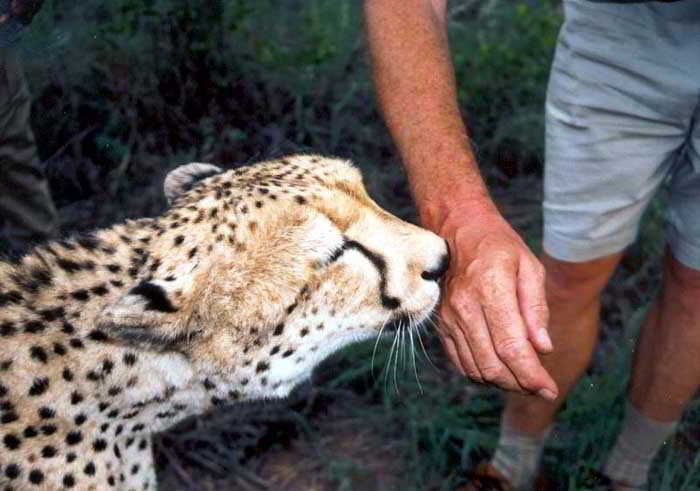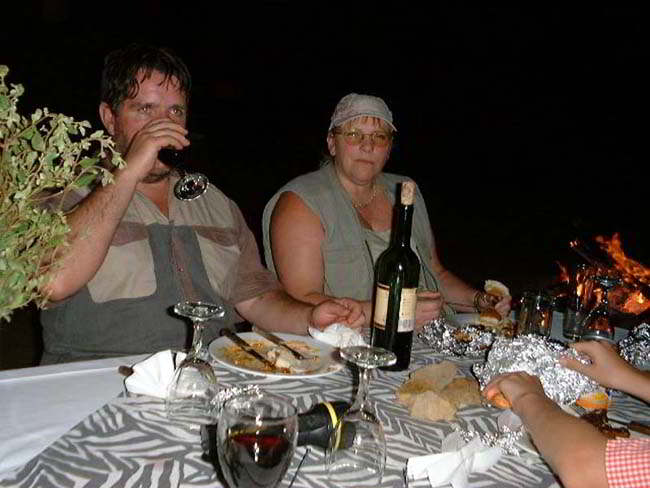‘Let’s try somewhere new,’ she said
The fun started when my sister-in-law, Sue, and her husband, Dave, were visiting us in Johannesburg. Well, you can’t have visitors from the UK and not take them to a game reserve, can you? After several years of enjoying trips to local game reserves, my wife suggested that it would make a nice change to go to one outside of South Africa. Botswana sounded good. At the time.
As is our habit, we loaded the huge boot of my Ford Explorer with more than we could ever need for our few days of holiday. Admiring the changing scenery along the way, the five-hour drive to Botswana was uneventful, with minimal delays at the border crossing between South Africa and Botswana. So far so good.
An unexpected welcome

In the gathering gloom of dusk, we arrived at Mokolodi Game Reserve, about 15km from Botswana’s capital Gaborone. As we entered the gates, two uniformed guards leapt to attention and saluted. You don’t get a lot of that in the UK. Dave was impressed.
We were the only guests at Mokolodi but we weren’t alone. What looked like a pile of dead leaves by the door of our chalet moved slightly as I walked passed. Looking closer we discovered a substantial Puff Adder, hissing loudly at being disturbed. Angry Puff Adders are also something you don’t get in the UK. This time, Dave was not impressed.
He and I checked under each bed for any further surprises, while the ladies said they would meet us at the restaurant. Who could blame them?
I probably didn’t help matters by telling them the Puff Adder is responsible for the most snakebites fatalities in Africa. I’ve always thought its scientific name Bitis arietans is delightfully descriptive. You’ve got to admit Bitis is a great name for a poisonous snake, right? And arietans basically means to strike violently. Lesley told me to shut up. She was probably right.
Animals galore
The next day, I peered cautiously out the door to check our scaly friend had moved on. He had, so we quickly clambered into the safety of the Explorer for our first drive looking for wildlife. With binoculars and cameras at the ready, we spent the morning exploring some of the 30 square kilometres covered by the game reserve.
We spotted giraffe, warthog, and dozens of impala, a large kudu bull, a few rhinos and the only herd of elephant. Despite their size, some of the large animals, including elephants, are ridiculously hard to see among the bushes. If you notice them at all, often they’re already running away. Dave nearly wore his camera out snapping the rumps of fleeing animals.
(The elephants are no longer at Mokolodi, having been transferred elsewhere as part of a breeding program).
Saving the cheetah in Botswana

After an early lunch, we went to the Cheetah Rehabilitation Centre which is part of Mokolodi and met Duma and Letotse, the resident cheetahs. Orphaned when a farmer shot their mother, these two cats are used by the Centre as ambassadors for the cheetahs of Botswana. Due to the conflict between livestock and predators, farmers have been killing cheetah to the point their numbers have plummeted. The Centre hopes that by educating the public, children and farmers, alternatives to shooting these lovely cats will be found.
It’s possible to interact with the cheetahs at the Centre. Even to a regular game reserve visitor like me, that was pretty neat. The cheetahs didn’t share our excitement. Their amber eyes registered complete disinterest as we stroked them. Which, given the size of their teeth, was a good thing. The coarseness of the fur surprised me. I thought it would be soft, like a domestic cat, but it felt more like rubbing the bristles on a broom!
Darkness descends

After a brief rest, heavy banging on the chalet door signalled it was time for our night game drive. The sunset in a stunning display of orange, red and lurid purples as we bounced along the rough track in the back of a jeep.
Blessing, the game ranger, used a powerful spotlight to help us glimpse a few of the well-camouflaged animals. Mostly, their shining eyes gave them away. We all thoroughly enjoyed ourselves in the jeep. There’s a wonderful feeling of being closer to nature in an open vehicle which you can’t get in a car. And perhaps a hint of danger? But I was impatient for the main event. The food.
All traces of the sun had long gone when the jeep pulled up to the outdoor braai (barbecue) area. A blazing log fire roared in the middle, sending flames high into the sky illuminating the immediate area. Smoke from the braai wafted tantalising smells of the different meats cooking. With rumbling tummies, we didn’t need further encouragement to exit the bone-shaking jeep.
Feasting and stories under the stars

We were escorted to the only table, carefully set with a white linen tablecloth and a bottle of wine: a bizarre sight in the middle of the African bushveld.
More familiar with the light-polluted skies of southern England, Dave was enthralled by the myriads of stars, twinkling like jewels in the black sky above us. Being in the Southern Hemisphere confused him a bit as constellations seemed to be in the ‘wrong’ place or upside down.
Sue was oblivious to wonders above us and more concerned with the racket from the unknown creatures surrounding us as they screeched, whistled and grunted in the veldt.
Before the noises could unsettle her further, an assortment of meats and sausages landed on our table, cooked to perfection. A few vegetables followed, accompanied by pap, a stodgy porridge made from maize that has the consistency of wallpaper paste. I stuck with the meat and wine.
As we ate, Blessing explained the origin of some of the animal noises but left a lot to our imagination. There were no lions here, he explained to ease Sue’s concerns. But leopards lived nearby, he added with a smile. When we pressed him about lions, he said he came from a small town near the Khutse Game Reserve on the edge of the Kalahari, where lions are not uncommon.
He was astonished we had no plans to visit the Kalahari. After all, he said as he drove us back to our chalets, it was a mere 250km north and we had a car. Why wouldn’t we go? We shrugged our shoulders, unsure how to reply. A 500km round trip to the Kalahari! Was he mad?
Next stop – the Kalahari!

Mokolodi has stables, so by mid-morning my daughter and I mounted our steeds to follow Blessing through the bush searching for animals. It is possible to get closer to wild animals on horseback than by car or even open jeep. But when we trotted near a herd of rhino, I felt very exposed and missed the sturdy metal frame of my Ford Explorer.
Dave, Sue and Lesley are not keen horse riders. They opted for a gentle stroll around the vicinity of the chalet while Dave tried to identify the abundant bird life. By the time Tabitha and I returned, weary and saddle sore, the decision had been made to visit the Kalahari.
Dave calculated the 250km journey would take about 7 hours, subject to the quality of the roads, some of which were not tarred. If we wanted to enjoy a full day there, we would have to drive through the night, leaving at midnight. I was aghast! I showed him a guidebook that said the journey should take about four to five hours but Dave is cautious by nature and was adamant we must leave at midnight.
As it turned out, even he was being optimistic. We nearly didn’t get there at all.
To be continued in The Kalahari Desert – Don’t try this at night!
For information about Mokolodi, check out these links:
